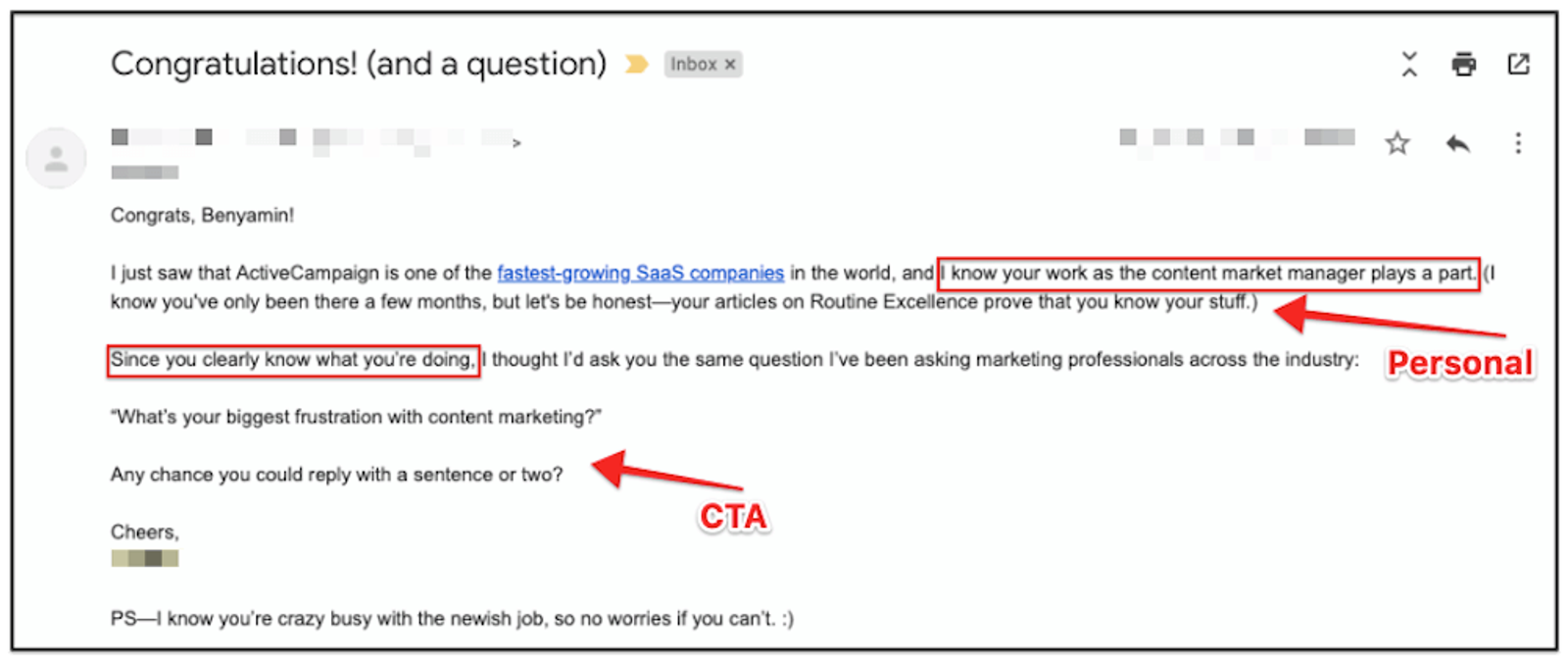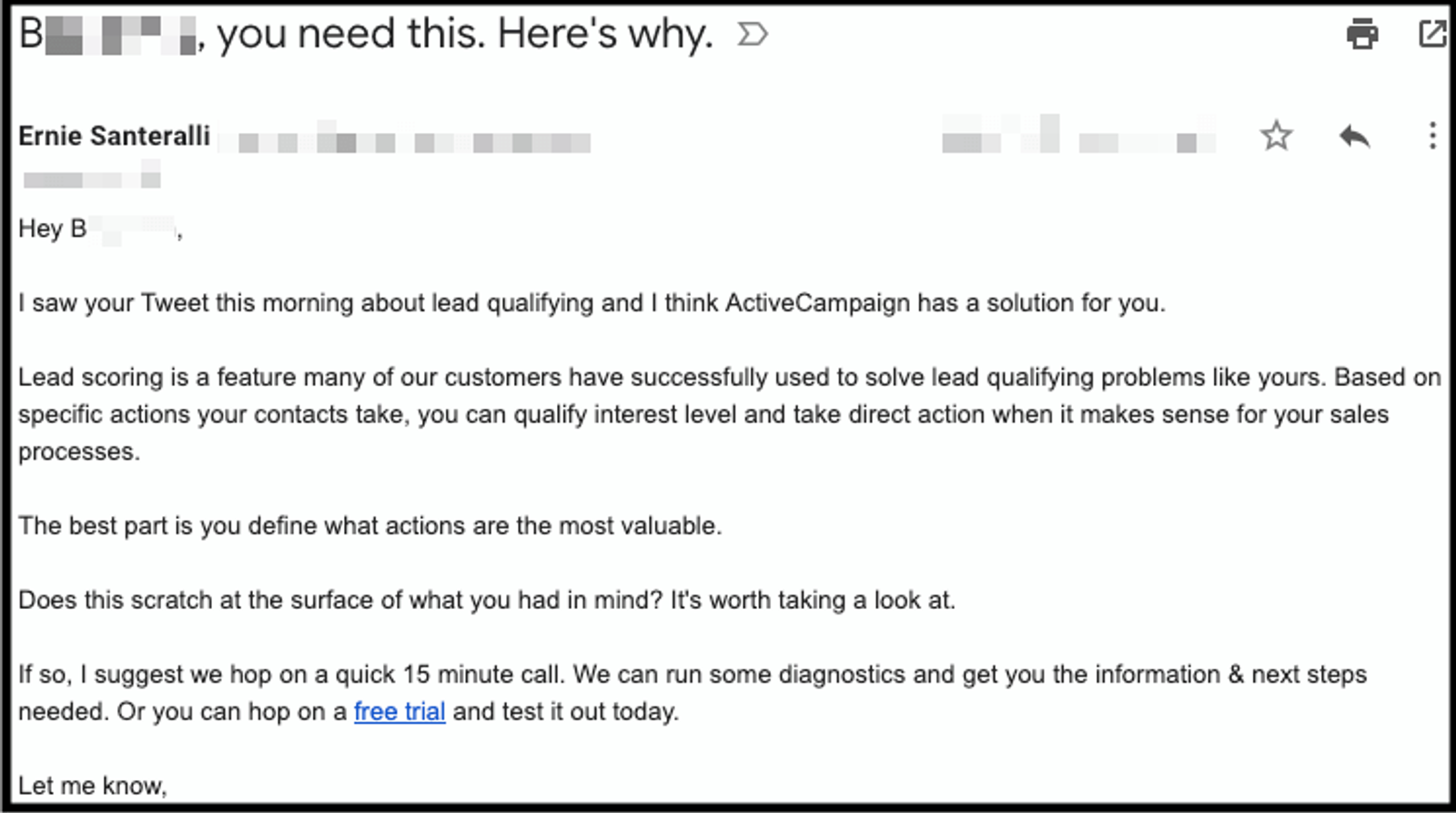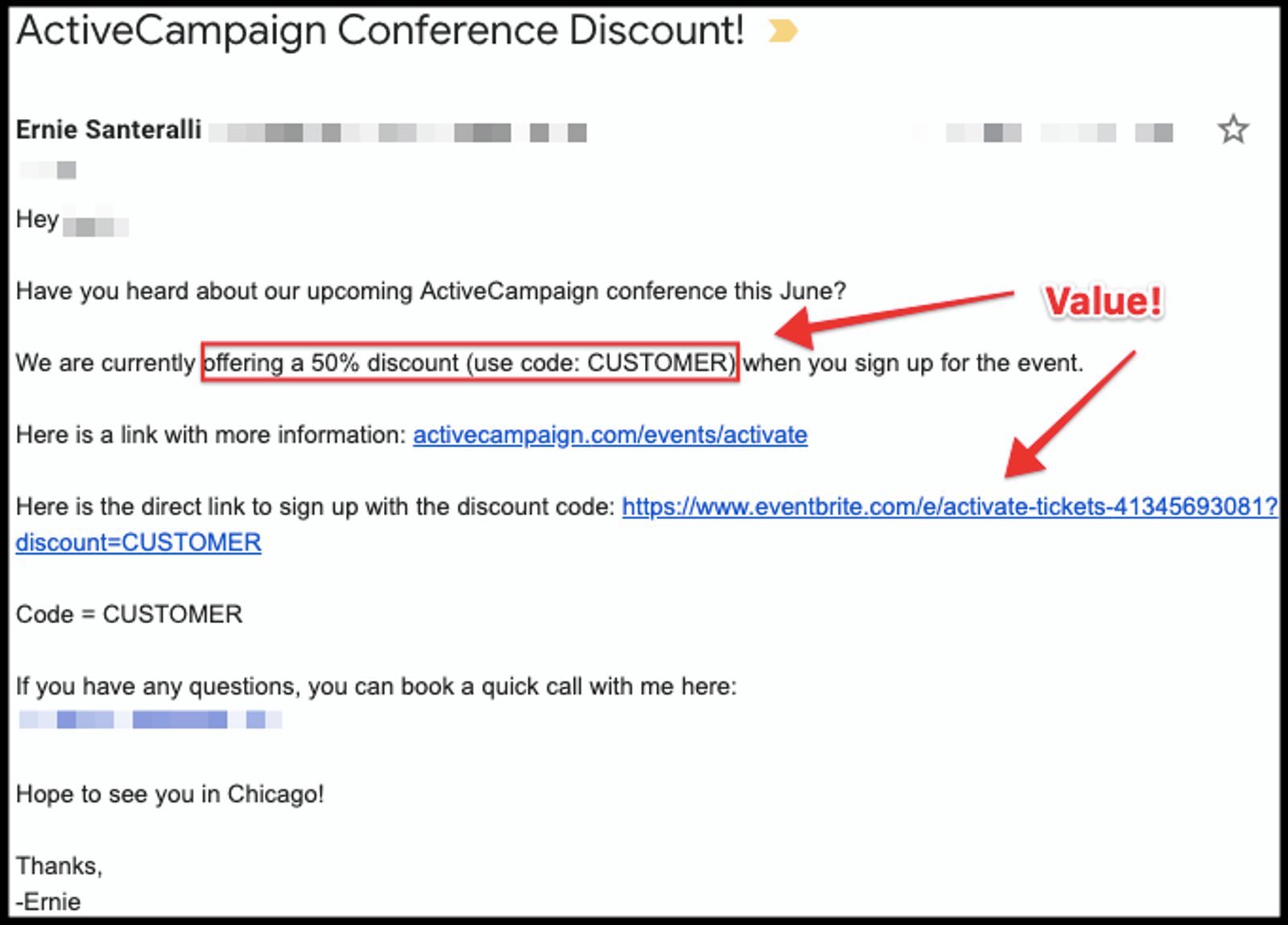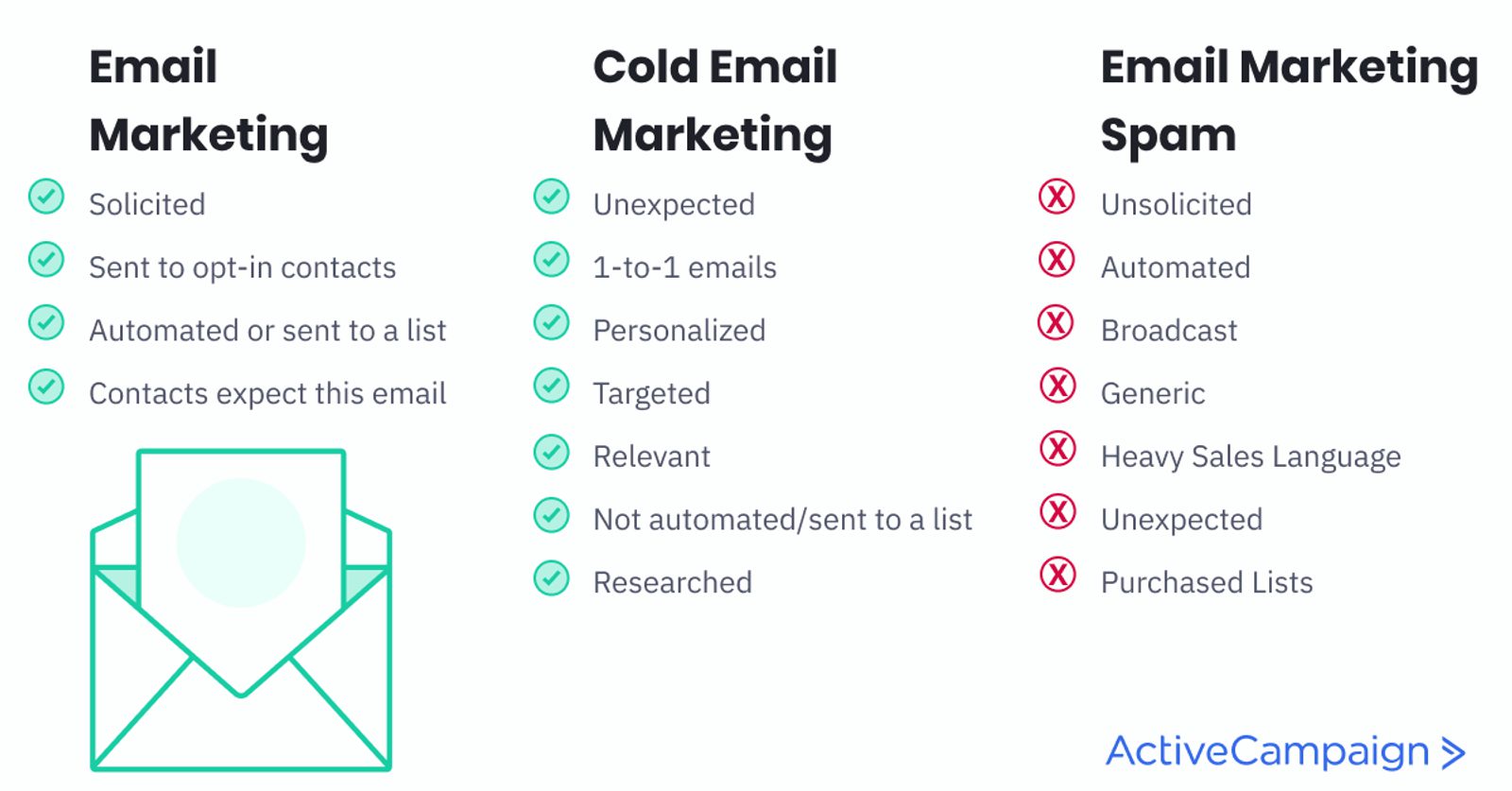Cold email is tricky. What do you send? Are there cold email templates you can use? Which cold email techniques actually work?
Is there a cold email template that you can use and get positive results?
In this post you’ll learn:
- How do you write a really good cold email?
- 10 cold email templates you can use (and why they work)
- 5 strategies for cold email follow up
- Cold email vs. spam email – what’s the difference?
What do you say in a cold email?
Cold email marketing is still an effective way to grow your business if you do it right. If you’re careless, you can end up doing more harm than good.
Most salespeople and marketers don’t take the time to craft a good cold email – and as a result the average cold email has a response rate of less than 1%.
How do you write a GOOD cold email?
You can send a cold email for any situation, but the good cold emails have common themes. They use some combination of the following qualities – I like to think of them as Cold Email Commandments
- Add value
- Are personalized and targeted
- Are relevant
- Have a call-to-action (CTA) of some kind
- Show that the sender has done their research
- Build credibility
- Use metrics or stats as proof
- Use psychology to their benefit
Quick note: “Add value” is a phrase that gets thrown around a lot. But what does it actually mean?
Adding value means you’re giving your prospect something relevant that they didn’t have before. This could be in the form of:
- New information
- Special offer or promotion
- A free trial or consultation
- An invitation to an event
- Answering a difficult question
- A relevant blog post, guide, or video
Make people consider something new. Or offer them something that has a clear monetary or time value.
10 cold email templates you can use today
- The relevant blog post
- “Congratulations!”
- We’re helping people just like you
- The case study
- The warm intro or common connection
- “You’re using a competitor, and here’s why we’re better”
- Our unique process/feature can help you
- The upcoming event + the discount
- Free trial or test run
- Free premium content or service
1. The relevant blog post
Blog posts are great ways to open a line of communication – but they have to make sense for the person you’re emailing. Sending a random blog with no context isn’t going to get you anywhere.
Open your email with why. Tell them why you’re sending them the blog, and tell them why they should care enough to read it. Then link the blog and include a CTA.
Good cold emails start a conversation. Conversations require responses, so include a CTA and ask for a response.
Take a look at the email example below:

“Here’s why I’m sending you this blog, and here’s why you should care.”
This cold email works because it follows a basic formula. The formula weaves personalization, value, metrics, relevance, and a CTA in while being conversational. It’s not pushy, too salesy, or suspicious.
Here’s the formula:
- I was on your website/social page/profile (personalization, research, relevance)
- I thought of this blog just for you that can help with ___ problem (relevance, personalization)
- Here’s why you should look at it (metrics, relevance, value)
- Here‘s a link to the blog (value)
- I can help you with this, let’s talk about it! (credibility, CTA)
Great cold emails almost always lead with personalization and relevance. You need to get your prospect’s attention as fast as possible and keep it.
2. “Congratulations!”
The congratulatory cold email is effective when done right, but it’s easy to mess up. When a prospect or company makes the news it’s a great opportunity to reach out.
But sending them a generic, “Congrats on your funding” or an even worse, “It seems like you're growing” is not what you’re looking for here.
Let’s take a look at an example:

Deep personalization, an ego boost, and a clear CTA. This “Congratulations” email sender should be congratulated
Why does this email work so well?
- Personalization – the email contains details that would only be known if the sender did their research. Mentioning specific job titles, linking an article, and touching on previous work is a great way to stand out.
- Ego boost – the “Congratulations” email works so well because of psychology (see the "esteem stage" of Maslow's Hierarchy of Needs). When you give recognition or praise to someone you boost their ego. This improves their view of you and increases the likelihood that they respond with what you’re asking for.
- CTA – the CTA flows perfectly from the compliment and is phrased as if the sender is asking for advice. According to Robert Cialdini, asking for advice works to the sender’s benefit because it causes the receiver to put themselves in a cooperative state of mind. They become more supportive of your idea before they experience it.
If you take the “Congratulations!” approach, make sure you hit each of these points. A lazy congratulations feels more like a forced apology than anything else.
Do your research and offer genuine, sincere praise. Your prospects will pick up on it, and your chances of opening a dialogue will skyrocket.
3. We’re helping people just like you
“One of the fastest ways to build credibility with your audience is to understand the frustrations and problems they are experiencing and be able to articulate them.” – Amanda Jesnoewski, Founder of Velocity Media and Communications
Use your current customers to get new ones. Show your prospects that you understand their problems and know how to fix them.
Sprinkle some metrics or use cases in to really cement your authority.
Take a look at the email below, which was sent to an SDR manager at ActiveCampaign:

Personalization, credibility, relevance, value, CTA. This is how you Cold Email.
The sender shows that they’ve done their homework in the first sentence and gets right to the point. From there, they outline their understanding of the problems. They know that hiring more SDRs means process training, and can cause confusion and mismanagement of deals.
Then they hit you with the proof. Two examples of companies that they’ve helped with this exact issue, plus the results. And finally, the CTA.
The formula:
- Lead with research and personalization
- Identify the relevant problem
- Show your understanding of the problem
- Offer proof using your current/past customers
- Lay out the results and potential benefits
- CTA
4. The case study
Like a blog post, a case study cold email needs to be relevant. The business in the case study should be similar to the business you’re emailing – in one of these ways:
- Industry
- Problem
- Company size
- Business model
If there’s no similarity, your email won’t make sense for who you’re sending to.
Case studies work well as cold emails because they:
- Establish credibility
- Provide metrics as proof of value
- Add value in the form of insight, ideas, or solutions

Hit on a relevant problem, offer a solution, ask for next steps. Also if you’re in real estate and want to learn how ActiveCampaign can help you manage relationships, click here!
Why does it work?
The problem is laid out in the subject line and the first sentence of the email. As a real estate professional, you come in contact with hundreds (if not thousands) of leads. It’s hard to stay on top of them all.
Then introduce yourself as a credible problem solver, and show them an example of your solution in action. As always, follow it up with a CTA for next steps.
The formula:
- Lay out the relevant problem, show that you understand their pain points
- Introduce a solution to the problem in the form of your business
- Prove it with your case study
- Offer next steps for a more in depth discussion
5. The warm intro or common connection
A quick way to build some rapport and ‘warm up’ a cold email is to highlight a common connection you have with your prospect. The connection could be:
- An acquaintance
- A colleague
- A friend
- An interest or activity
- A school or course

Warm up the conversation with a common interest.
This email is a good example of using a common interest (in this case it’s content and email marketing) to open a dialogue. It also works because the sender has already done something for the prospect and they don’t even know it yet.
Your stock rises if you start the conversation with something you’ve already done for them. They have little choice but to at least check it out.
Mention a common colleague or friend and improve their view of you through a process called ‘social categorization’. They don’t know much about you, but they will infer things based on what they do know, which is that you share a common connection. It also proves you’re a real person.
The formula:
- Hint at your connection or interest in the subject line (a little extra personalization doesn’t hurt)
- Introduce what you have in common quickly and directly
- Show them why it matters
- Transition to the CTA and keep the conversation going
6. “You’re using a competitor, and here’s why we’re better.”
Do you have a prospect that’s using the competition? Do you know that you could do the job:
- Better
- Faster
- Cheaper
- Smoother
Let them know!
The competitor cold outreach shows that you’ve done your research. It also gives you an opportunity to show what makes your business better, and give numbers to back it up.

Be sure to back up your claims with links, metrics, or some type of proof. And if you’d like to explore the ActiveCampaign +Thinkific integration, click here!
The formula:
- Show your research with a mention of the competitor
- Touch on relevant areas where you exceed the competitor
- Reinforce your claims and establish credibility with proof and/or metrics
- Provide next steps with a CTA
7. Our unique process/feature can help you
Do you have a process that sets you apart from everyone else in the space?
Use that in your cold email!
Lead scoring isn’t a new idea. But our lead scoring customization is. It separates our lead scoring system from the other systems.
What makes your business different? What makes it better?
Remember, whatever separates you from everyone else has to be relevant to the person you’re sending to.
The “unique process” email gives opportunities to show how effective your process is. You can include:
- Metrics or statistics as proof
- A case study highlighting the process
- Insight on the process to establish credibility
- A CTA to take the next step

Not only do we have a solution to your lead qualifying problem, but we have a solution that you can customize!
The formula:
- Identify a relevant problem or reason for reaching out
- Present your process as a solution
- Show them how your process is different
- Back it up with metrics, stats, case studies, insight
- Establish next steps with a call-to-action
8. The upcoming event and the discount
Cold email marketing is about building relationships with prospects. A great way to start a business relationship is to invite your prospects to an upcoming event.
Relevance (as always) is key. Make sure the prospect would benefit from attending the event before you invite them.
Take it a step further and give them a discount on admission.

Not only are you invited, but we want you to come so badly we cut the price in half! Also, have you heard about ActiveCampaign’s study halls?
Why it works: Invitations are personal. You thought of them because you know they’ll benefit from the event, or you want them to come. People tend to like people that like them, and inviting someone to an event is a sign that you like them.
Invitations are noninvasive. They’re not pushy or annoying (so long as they’re relevant).
Discounts add value to your invite. Discounts create happiness and increase the chances of a purchase or action. They’re happy because they get a great deal on the event, and you made it happen!
The formula:
- Make sure the event is relevant for them
- Make sure they know the event is relevant for them
- Personally invite them to the event (and hit them with a discount)
- Include a CTA to talk more or answer any questions they have
9. Free trial or test run
FREE.
Can you feel that?
That’s the zero price effect. The demand of a product/service skyrockets when the price is 0. And you can use this in your cold outreach! Let them try your product for free!
- Free trial
- 1-Month subscription
- Sample of your product
Speaking of which:
This isn’t a cold email…
Take a look at how ActiveCampaign uses “free” in our cold email outreach:

See for yourself! It’s free!
The beauty of offering something for free is that you’re selling without selling. You let your trial do that for you.
Notice the words, “offer you an opportunity to try”. It’s simple, but it works to create urgency and hints that not just anyone can sign up (even though anyone can).
Give them a limited trial run for nothing. It adds credibility and uses psychology to your advantage.
But make sure that the trial is useful and helpful to each particular prospect. Irrelevant freebies are annoying and unhelpful.
10. Free premium content or service
If you don’t offer a free trial, give them something else!
Offer them free premium content, like:
If you don’t have premium content, give away a service.
- Strategy discussion
- Promotion of their brand
- Assessment
- Recommendation
- Product Training
- Onboarding or migration
Anything relevant to their situation or helpful to the prospect is worth a try. Take a look at the email below:

You’ll promote our content… for free?
This email does some things right and one thing wrong (it’s ActiveCampaign with a capital C). However, an offer to promote the blog to over 120,000 marketers is enticing. Why else does it work? Because it:
- Is relevant and targeted
- Uses numbers to boost credibility
- Offers clear benefits
- Gives an example
- Includes a CTA
The formula:
- Tell them why you’re reaching out and why it should matter to them
- Show them why it should matter to them with metrics, numbers, or stats
- Translate the metrics into potential benefits
- Give an example of what the end product looks like
- CTA to keep the conversation going
5 strategies for cold email follow up
Email has a short life span. Over 90% of email opens and replies happen in the first 24 hours. So don’t wait around if you don’t get a response in a day or two. Instead, get back in there and send a follow up!
The thing is, 70% of people don’t send a follow up email! Don't be in that category.
There are an infinite number of ways you can follow up a cold email. But make your follow up worthwhile. Don’t send that follow up email it if only consists of:
- “Hey, did you see this?”
- “Per my last email”
- “Want to bump this up to the top of your inbox.”
- “Just wanted to reach out again”
Instead, send a follow up email that does something for your prospect. Here are 5 follow up strategies:
- Be funny
- Give more things away
- Create some urgency!!!
- “I want to make sure you have everything you need”
- “Are you the right person for this? Should I contact someone else?”
1. Be funny
Humor is effective when you do it right. But it’s a big risk because it’s so easy to get wrong. Your joke has to land to inspire a reply. If your joke doesn’t land, your chances of getting a reply at any point in the future dwindle.
Not everyone finds the same things funny, so go for something with a wider appeal. Use visual appeal:
- an image
- a gif
- a video
If you can make them laugh you'll be more memorable and they'll like you more. Also, they’ll reply.
2. Give more things away
Give some more stuff away for free.
- Offer another strategy call
- An invite to a second event
- The slides or material from the first event
- More premium content
We know that people love free stuff. If you show them you have more to give, you become more credible and likely to get a response.
3. Create some urgency!!!
- “Time is running out!”
- “Only 3 spots remain!”
- “This opportunity expires at midnight”
- “Claim yours before they’re gone!”
Urgency is a powerful motivator. Studies show we prioritize urgency over importance. I’m not saying you should try to pull your prospects away from their important work, but a follow up that creates urgency is a great tactic to encourage a reply.
4. “I want to make sure you have everything you need”
Many of us don’t like to ask for help. We don’t want to appear weak, needy, or incompetent. They might have questions about your initial outreach, or be curious about a certain part of it.
Let them know you’re there to help them, and ask them to ask you for help! Take it a step further and ask a more direct question to encourage dialogue.
“What parts of your email marketing strategy are especially important for your business?” does a lot more than, “Are you marketing with email?”
Many times prospects don’t know how to start answering a broad question. A question that makes them think about a certain piece of the topic is much more likely to get a response that leads somewhere.
5. “Are you the right person for this? Should I contact someone else?”
Sometimes you get it wrong. You thought you had the right prospect for your outreach, but you missed the mark.
It happens. All organizations are different, and people handle different roles. Sending a courtesy check follow-up works for two reasons:
- If they’re the wrong person, they’ll tell you so you stop emailing them
- If they’re the right person, they’ll tell you because people like recognition
Cold email vs. spam email: What’s the difference?
There are 3 key differences between cold emails and spam emails.
- Personalization
- Intent
- List vs. 1-to-1
If you hit them all, your emails stand a much better chance of success. You’ll get more opens and replies – and more of your emails will make it through the spam filters and land in your target’s inboxes.
Personalization is the most important factor in getting your emails opened and replied to. Here are 4 areas to personalize in your emails:
- Your prospect’s name
- Your name and email address
- Information you have gathered from research
- Subject line
Spam emails never personalize to this level. They are broad and nonspecific. Apart from the occasional use of “name,” there’s nothing in a spam email that would make it seem like it was written for you.
Cold email campaigns are relevant and thoughtful instead of impersonal and unwelcome.

Take the time to do it right, and stay out of the spam folder!
So, what makes a ‘good’ cold email template?
Effective cold emails do at least three things:
- Give the prospect something they didn’t have before (add value).
- Include personalized details and information
- Touch on something that is relevant to the prospect
Great cold emails add in something extra:
- Have a call-to-action (CTA) of some kind
- Show that the sender has done their research
- Build credibility
- Use metrics or stats as proof
- Use psychology to their benefit
There are an infinite number of ways and reasons to send a cold email. If you want to stand out and get responses, these Cold Email Commandments will help you get there.







